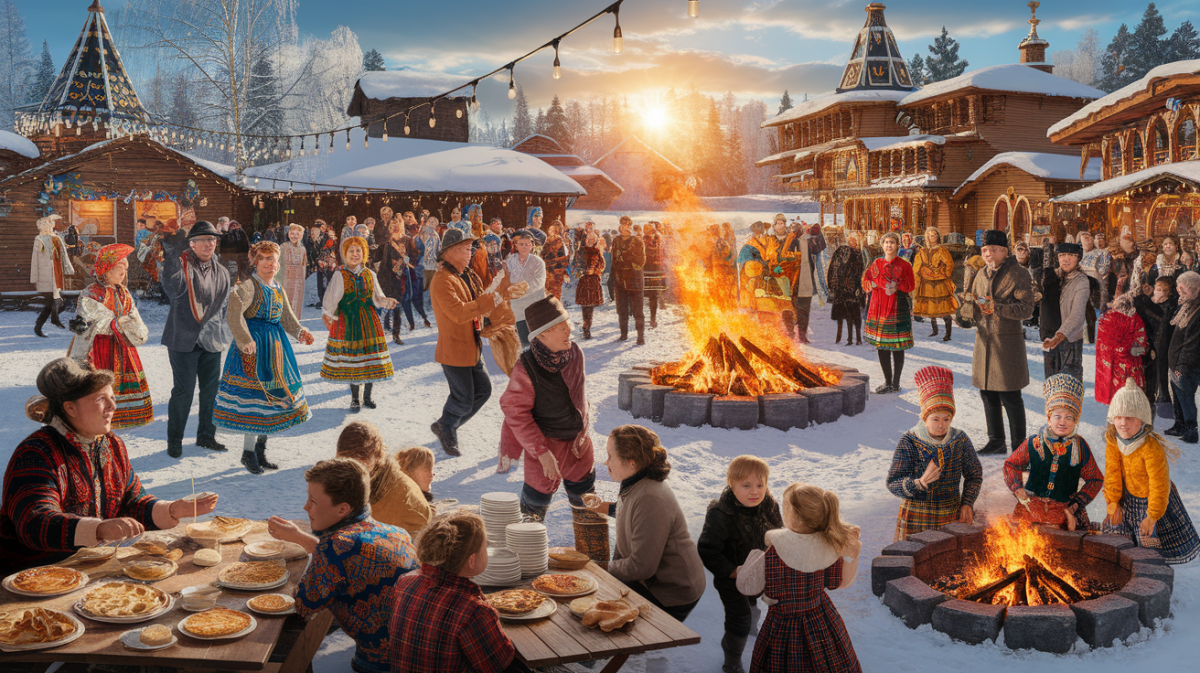“`html
EN BREF
“`
La Maslenitsa, souvent qualifiée de « semaine des crêpes » ou « semaine du fromage », est un festival populaire russe haut en couleurs, qui se déroule chaque année la semaine précédant le Carême orthodoxe. Héritage des Slaves orientaux, la Maslenitsa mélange traditions païennes et chrétiennes, marquant symboliquement la fin de l’hiver et l’accueil du printemps. Cette fête, parsemée de rites anciens, est l’occasion d’une joyeuse exubérance connue pour ses festins de blini—de savoureuses crêpes symbolisant le soleil—et ses célébrations communautaires, incluant des balades en traîneaux, des batailles de boules de neige et des feux de joie. Au cœur de ces festivités se trouve la tradition de brûler une effigie de paille, la Mazlenitsa, pour dire adieu à l’hiver. Bien qu’elle partage de nombreuses similitudes avec le Carnaval chrétien occidental, la Maslenitsa se distingue par ses racines profondément ancrées dans la culture slave et ses contributions uniques aux rituels de renouveau. Réunissant famille, amis et voisins, cette semaine de liberté face aux interdits du Carême est un moment clé du calendrier russe, empreint de chaleur et de convivialité.
Historical roots of maslenitsa
The Maslenitsa festival, a vibrant blend of folk and religious traditions, holds roots tracing back to ancient Slavic mythology. As per archeological evidence, it stands as perhaps the oldest surviving Slavic festival. Celebrated in Russia, Ukraine, and Belarus, Maslenitsa marks the end of winter and the start of Great Lent for Eastern Orthodox Christians.
The origins of Maslenitsa lie in pagan celebrations, representing a farewell to winter’s harshness. It is a time-steeped ritual, intertwined with Slavic mythology where gods of the sun and fertility are honored. Over time, this pagan observance was embraced by the Orthodox Church. Today Maslenitsa signifies the last period for joyful feasting and gatherings before the solemnity of Lent begins, with its arrival depending on the date of Easter each year.
During Maslenitsa week, work is already forbidden for Orthodox Christians. It represents the “last free week” before Lent, a period known historically as “Freedom week”. This week’s significance lies in its blend of historical customs that illuminate why this festival maintains such a passionate observance among Eastern Slavs worldwide.
Maslenitsa customs and activities
The festivals’ festivities weave various traditional customs into a series of delightful activities enjoyed by many. Each day of the week-long celebration offers unique cultural practices and rituals that vary across regions. Common activities include making and eating blini (crepes) and participating in communal events like sleigh rides and bonfires.
The festival often begins with the welcoming of “Lady Maslenitsa”, a straw effigy decorated with colorful rags. This symbolic figure is paraded through communities before its ultimate demise in a bonfire, symbolizing the cleansing and rejuvenating nature of spring. This represents both a cheerful farewell to winter and an invitation to warmth and light.
Outdoor activities like sleigh rides and snowball fights dominate the later days of Maslenitsa. Participants joyously embrace the fleeting joy of winter before it yields to the new season. Such traditions serve not just as entertainment but as communal bonding experiences, leaving an indelible imprint on regional cultural consciousness.
Forgiveness Sunday: an integral part of maslenitsa
The culmination of Maslenitsa is the poignant observance of Forgiveness Sunday, which embodies the spiritual transition from festivities to the contemplative introspection of Lent. On this day, families and friends seek forgiveness from one another, extending gestures of compassion and unity before undertaking the Lenten journey.
This tradition reflects deeply in Orthodox Christian teachings, marking Cheesefare Sunday, when practically all dairy products are consumed as a final indulgence before the strict Lenten fast. On Forgiveness Sunday, small gifts may be exchanged as symbols of reconciliation, and leftover pancakes might be sacrificially thrown onto the effigy bonfire.
Beyond its religious aspects, Forgiveness Sunday fosters a greater sense of community and empathy. The act of forgiveness is also physical; offerings of bows—called poklons—are made, underlining the interpersonal ties that knit communities. This endearing tradition highlights the festival’s ethos, where chances for social engagement harmonize with moments of forgiveness and personal reflection.
The evolution of maslenitsa celebrations
Maslenitsa’s journey through centuries reveals a dynamic evolution shaped by cultural and political climates. Entering the 20th century, large public celebrations waned due to societal upheavals, particularly post-1917 Russian Revolution. With state-imposed atheism in the Soviet era, Maslenitsa took on a quieter, more private semblance sustained within households and rural locales.
In the latter 20th century, as the Soviet Union sought to reintroduce traditional holidays, the festival witnessed a reimagining. Despite socialist elements shaping the celebrations, the festival’s essential customs remained resilient. When perestroika emerged, the festival enjoyed a renaissance, rekindling large outdoor celebrations that harmonized traditional and modern elements. Notably since 2002, Moscow’s annual Maslenitsa festival near Red Square has embodied this revival, drawing vast crowds to immerse in the cultural spectacle.
This adaptation illustrates how cultural practices can both preserve tradition and embrace change. Even with increasing secularization, Maslenitsa endures, with many regions using the festival to showcase Russian culture, engaging both its native diaspora and global audiences in a celebration of enduring legacy.
Modern cultural significance and global influence of maslenitsa
Beyond its geographical origins, Maslenitsa’s cultural significance extends globally through Russian diaspora communities and enthusiasts of Slavic traditions. The festival serves as a vital touchstone for cultural identity, echoing traditions through joyful exhibitions and refreshments like blini and pierogi.
With its unique position as precursor to Lent, the festival offers a glimpse into the intra-communal relationships that define Eastern Slavs’ social fabric. The rituals performed during Maslenitsa resonate well with contemporary focus on cultural preservation and identity expression, solidifying why it remains a beloved tradition for those within and beyond Eastern Europe.
In the spirit of globalization, countries with significant Russian immigrant populations celebrate Maslenitsa, albeit often condensed into a single day. These reimagined celebrations aim to connect younger generations with their roots, fostering cultural cohesion and ensuring the festival’s endurance as a living tradition.
| Activity | Description |
|---|---|
| Blini Making | Involves making traditional Russian pancakes enjoyed throughout the festival. |
| Lady Maslenitsa Parade | The ceremonial effigy is paraded through towns, symbolizing the winter’s farewell. |
| Sleigh Rides & Snowball Fights | Enjoyed as communal outdoor activities that celebrate the last days of winter fun. |
| Forgiveness Sunday | A tradition of seeking forgiveness as the festival culminates, signifying Lent’s approach. |
Folk Celebrations and Carnival Traditions of Russia’s Maslenitsa Festival
Maslenitsa stands as a vivid tapestry of traditional Eastern Slavic culture, weaving history, mythology, and religion into a single week of vibrant celebration. Serving as an ancient herald of the spring season’s arrival, this festival is a fusion of folk customs and religious observance, dating back to possibly the 2nd century AD. Each day unfolds with its own unique traditions, offering a rich variety of activities and forms of social expression that showcase the harmonious coexistence of pre-Christian and Christian customs.
The spirit of Maslenitsa is most vividly captured in its carnival-like atmosphere. The use of effigies in these celebrations is deeply symbolic, with the burning of the Maslenitsa scarecrow signifying the end of winter and the regeneration of life. This act of communal participation not only marks the seasonal shift but also serves as a metaphorical cleansing, preparing the mind and spirit for the pensive season of Great Lent. Numerous activities engage all age groups, from joyous sleigh rides to energetic snowball fights, a testament to the festival’s role as a public display of unity, tradition, and fun.
Beyond the fervor and laughter lies a reflective dimension to the Maslenitsa episodes, especially evident in the observation of Forgiveness Sunday. The poignant act of asking for forgiveness and preparing for Lent underscores Maslenitsa’s role as a microcosm of life’s cycles—celebration, reconciliation, and renewal. This duality ensures the festival remains not only a fun-filled event but also a period of spiritual preparation and introspection.
Maslenitsa is more than just a festival; it is a significant cultural phenomenon. As communities revisit ancient rituals and enjoy festivities with historical roots, they honor a collective cultural identity that Russians, and other Eastern Slavs, preserve with pride. In doing so, Maslenitsa offers the world a compelling glimpse into the soul and vibrancy of Slavic heritage, reminding us that folk celebrations are not just about the past but a living tradition contributing to the cultural tapestry of today.
“`html
FAQs: Folk Celebrations and Carnival Traditions of Russia’s Maslenitsa Festival
Understanding the Maslenitsa Festival
Q: What is Maslenitsa?
A: Maslenitsa, also known as Butter Week, Crepe Week, or Cheesefare Week, is an Eastern Slavic religious and folk holiday, celebrated as the last week before Great Lent. It is known for its vibrant festivities and traditional customs.
Q: What are the key celebrations during Maslenitsa?
A: Key celebrations include baking blini (crepes), sleigh rides, dressing up in costumes, snowball fights, and the burning of the Maslenitsa effigy. In Ukraine and Belarus, varenyky with cottage cheese are also traditionally consumed.
Q: What is the historical significance of Maslenitsa?
A: Historically, Maslenitsa is possibly the oldest surviving Slavic holiday, with evidence dating back to the 2nd century AD. It marks the transition from the winter season and is the last chance for social activities before the introspective Lenten season.
Q: How does Maslenitsa relate to marriage traditions?
A: During Maslenitsa, particularly in Ukraine, marriage traditions were humorously highlighted. Unmarried men and women might have logs tied to their legs, symbolizing a playful punishment for not marrying before Maslenitsa, emphasizing the importance of marriage.
Q: What is the significance of Forgiveness Sunday during Maslenitsa?
A: Forgiveness Sunday is the final day of Maslenitsa, where relatives and friends seek forgiveness from each other and often exchange small gifts. The day concludes with the burning of the Maslenitsa effigy, a symbolic gesture to say farewell to winter and prepare for Great Lent.
Q: How has the celebration of Maslenitsa evolved in modern times?
A: Following periods of lesser prominence during the Soviet era, Maslenitsa has seen a revival post-1990s, encompassing both traditional and contemporary elements. Large public celebrations now occur, particularly in Moscow, celebrating both religious traditions and Russian cultural identity.


